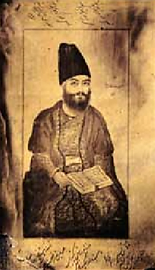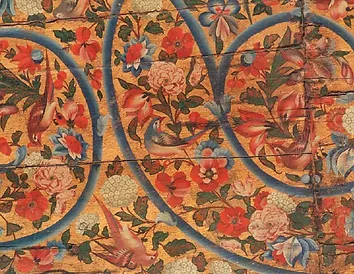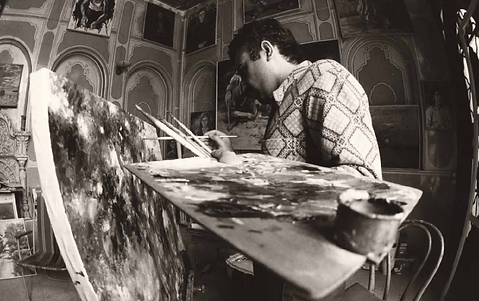Overview
Gholamhossein Saber was born in 1941 in Shiraz to a family with an artistic bent and a long history of enthusiasm for arts and literature. He started painting from early years and emerged as artist in early sixties. He has been painting for more than 60 years and has taught and influenced many artists who now have become known independent painters working in prestigious art centers across the globe. Saber’s styles include impressionism, post-impressionism, expressionism, and naturalism. The subjects of Saber’s work include landscapes of mountains, plains, gardens, old trees, people and their daily lives, and also the spectacle of the migration of nomadic women, portraits and figures, and still lives. He has been awarded as a Distinguished Artist multiple times including a National Distinguished Artist Award for Lifetime Achievement in 2019.
FAMILY History & EARLY LIFE
Gholamhossein Saber was born in 1941 in Shiraz to a family with an artistic bent and a long history of enthusiasm for arts and literature. His great grandfather, Mirza Mehdi Saber, who lived in the era of Mohammad Shah and Nasser-al-Din Shah, was a poet and calligrapher, and left behind a collection of poems. Saber said, “I have a draft of the collection in hand, but a chance of publishing it has not arisen. The only work published by him is the ending of the tale ‘Shirin and Farhad.” The book Vahshi Bafqi, edited and arranged by Hossein Nakha’i, mentions: “Due to death, Vahshi Bafqi was not able to finish his ‘Shirin and Farhad.’ Vesal Shirazi, one of the famous poets of Shiraz, decided to complete that poem. He also met his end without being able to fulfill this wish. As Mirza Mehdi Saber was a companion of Vesal, he decided to finish the poem himself, concluding it in 304 verses. In other books, as well, he has been briefly mentioned, and some of his poems have also been cited. For example, Forsat al-Dowleh Shirazi praised him in his book Asare Ajam and wrote, “The late Mr. Mahdi had plenty of merits and was well-versed in the Nasta’liq.” Hajj Mirza Hassan Fasa’i also referred to him in Naseri’s Book of Fars, writing, “Mr. Mehdi Saber Shirazi, under the nom de plume of Saber, was graced with accounts of his virtues, and passed on in the 1900s.” The late Hassan Emdad also recounted Saber’s life story in the book Literary Societies in Shiraz.
After his father’s death, Mirza Mehdi, who was six at the time, was taken in by the great Mashir al-Malek, becoming his stenographer and secretary in adulthood. At the time of Mashir al-Malek II, he had the same position and was loved by him. Moreover, numerous books remain containing his handwriting. Due to the friendship Mirza Mehdi had with the family of Vesal, after his death, Vesal’s son, a contemporary poet of his time, composed a poem to be carved on his gravestone under the nom de plume of Vaqar. In keeping with this distinguished background, Gholamhossein Saber’s father was also an artistic and well-informed man; he was fond of poetry and sometimes composed poems as well. “My father read a lot of poetry; I remember him revisiting the Masnavi8 several times. He read Bustan, Golestan and others poems of Sa’di repeatedly, and reading the poems of Hafez was one of our family traditions. He was very fond of nature and took us for excursions at the outskirts of Shiraz. He showed us flowers, trees and birds and described each of their traits. He knew the clouds very well, and often made correct predictions of the weather judging by the shape and direction of their movements. Whenever he saw a cloud, he could tell whether it would produce rain, snow or lightning. Based on the direction of its movement, he was able to specify the amount of rainfall. This information, which he had learned empirically, was taught to us from childhood. He was a treasure trove of stories. At night, we would go home looking forward to hearing his stories, and being aware of our enthusiasm, he would tell us the stories on the condition that we were good and refrained from doing bad things. So we tried to be good children so that we could hear his stories. He told the stories quite charmingly with beautiful wording. He was a great speaker. Everyone was fascinated by his words in any gathering at which he was present. “When I think about what made me become a painter, I realize that more than anything, it was because of my father. He did not apprentice me to a master or encourage me to paint, but his love of nature and books led me to painting. “Regarding my artistic activities, my mother had a similar role to my father. She always wished for me and my siblings’ development, sometimes more than my father. At home, she was the one who was more attentive to our schooling, lessons, and grades, and when necessary would pay a visit to our school.
My mother, though not able to read and write, was eloquent and a fine speaker when talking in daily conversations. The reason for this was, in my opinion, her marriage to my father at the age of 14, which extended her knowledge under his influence. My parents were cousins. My mother’s family also had a close relationship with the Mozheb Bashi family. The Mozheb brothers were all artistic and were very proficient in manuscript illumination, calligraphy, and bookbinding. Now the illuminations of the Mozheb Bashis are considered well known and artful. “My mother was quite sociable, and until the last days of her 87 years, she did not lose her dignity and hope for life.9 She appreciated it when we read a book to her, enjoyed watching films and listening to radio plays. She had her own radio and followed the news. When we took her to the cinema, watching good films pleased her very much. She was very adept in cooking and made a variety of meals, and we were lucky in this sense! She was always worried and taking care of us. She believed that upbringing was the most important thing, and even the dearest child would have no value without manners. That is why she never spoiled me or raised me to become selfish. I was content with what I had, and did not have unreasonable demands; the only time I was able to, more or less, meet my demands was when I became employed myself. “My eldest sister, Badri Khanum, helped my mother a lot in her chores. She was a teacher, skilled in embroidery, sewing and other crafty work. For this reason, she became an art teacher and was for some time also the principle of a girl’s conservatory in Shiraz. “When I was a kid, all my five sisters took care of me and watched my behavior. My youngest sister, Maryam, was three years older than me and was my friend and playmate during my childhood. We did everything together. She even fed me and put food in my mouth when I was very young. This friendship lasted until we grew up. Later she became interested in literature, which was also my father’s influence. Most nights she read a book for all of us. She read poetry by Sa’di, Hafez and other poets, and often won poetical contests.”

Mirza Mehdi Saber, great grandfather of Gholamhossein Saber


Hand written poem by Mirza Mehdi Saber
Home
Saber was born in a house that was about two hundred years old. The house was from the same period as the houses of Zinat ol-Molook and Qawam ol-Molk, which were located in one of the oldest neighborhoods of Shiraz near Shah Cheragh and above the western entrance of the New Mosque11. There was a small pool in the middle of the courtyard, surrounded on three sides by rooms with darak (colored single- and double-hung windows). It had two gardens whose sour orange trees were green all year long. In summer, the fragrance of geranium and jasmine flowers could be smelled from several houses away. When pool water was poured on the brick flooring of the courtyard, the scents of soil and sour orange leaves and geraniums took all the fatigue away from the body and soul. He grew up in that house, and his bittersweet memories all took shape there. “The most prominent location in the house was the guest room, the roof of which was covered with paintings of flowers, birds, and arabesque. It was a beautiful piece of work and exemplary of roof painting, representing the skill of painters during the Qajar era in Shiraz. This roof attracted my attention from childhood, and I enjoyed lying on my back and looking at it for hours. It was gorgeous, and most importantly, this roof revived my oldest childhood memory: I was lying on a hammock, and when I opened my eyes after a long sleep, the first thing I saw was a dazzling roof, full of flowers and birds above my head. Then, through the large windows of the room, I saw the courtyard and its brick walls, the top of which was reached by the afternoon sunlight. This was my first image of the world; a beautiful memory that is permanently in my head. “When it rained, the raindrops falling on the small pool and the mingling circles they created fascinated me for hours; when it snowed, I became so excited that I even lost my appetite. I sat constantly by the window and watched the snow falling. On the roof of the house, I spent many minutes looking at the sun moving through the clouds or watching the birds fly. On summer nights, when we went on the roof to sleep, as I lay down, I gazed at the moon, stars and meteors falling until I fell asleep. “My father had bought the house ten years before I was born, and I lived in it for sixty years. I knew every corner and angle of that house well, from the courtyard to the many rooms, and I felt very comfortable there. “I admit that there was no better place. As long as my dad was alive, we had very pleasant nights, full of good discussions that kept us engaged. Remembering those unforgettable days and nights still occupies my mind.”
Books
“I remember when I was very young, on some nights, when my dad arrived home, he brought novels for my sisters. I had five older sisters who began reading them in turn. My father borrowed these books from the Ma’refat bookstore, run by Hossein and Hassan Ma’refat’s father12, because he had close ties with him. I also remember him from an early age; he was humorous and cheerful. “During childhood, all I dreamed of was becoming so educated one day that I would be able to read books like my father. My wish came more or less true when I was in fifth grade and became able to read any book easily. I borrowed books from the Beladi Bookstore and read them. At that time, Mr. Beladi was a young man in his twenties. He had a small shop on Zand Street, between Mardani Alley and Anvari Street. Until recently, he ran the place himself for as long as he was alive. He was considered one of the most valuable booksellers in Shiraz and lived for about 90 years. “The first book I read was Eagle’s Nest, a novel describing the fate of Hasan Sabah. Gradually, I became interested in French writers and read books by Alexandre Dumas and several other writers, whose novels told stories of medieval knights. I loved The Count of Monte Cristo; before reading it, my father had already told me all its stories. I read Histoire De Louis XVI Et De Marie-Antoinette and other books by Dumas13. I gradually opted for more complicated books, namely by Balzac, Stendhal, Guy de Maupassant, and so on. If I were to name them all there would be a lot. Apart from that, I was interested in studying astronomy and mathematics in simple language. The translation and printing of such books—for example, Astronomy for Everybody and a book about space by a German writer and scientist called Bruno Hans Buergel—had just begun at that time. One, Two, Three Infinity by George Gamow was one of the best books that described astronomy, mathematics and Albert Einstein’s theories in simple language. I had developed an avid interest in astronomy, which coincided with the launch of Sputnik 1 in space in
October 1957. Perhaps this event, known as the beginning of the space age, made me more enthusiastic about astronomy. I began reading many books and magazines on the topic.”

Ceiling of the house where Gholamhossein Saber was born and lived till 2001

Beginning Painting
When the Reza Shah Elementary School was founded in 1952, it was the first school in Shiraz to be run by European schools’ methods. As a result, besides classrooms, they had provided facilities such a laboratory, library and various workshops, including a painting workshop, and of course, the teacher of each class was the supervisor and educator of all of these workshops. Saber studied fifth and sixth grade at this elementary school. “This school gave us the opportunity to do artistic work and provided us with free artistic equipment,” he said. “One day, when our teacher (Mr. Farzan) asked who wanted to paint with watercolor, I raised my hand and expressed my enthusiasm even though I had no prior knowledge of painting. Ever since the day I started painting, I never put my pencil down. My work quickly exceeded my painting classmates’ and became an exemplar at school, and the classroom and corridor walls were filled with my paintings. At that time, most of my paintings were landscapes inspired by the gardens around the school.” After finishing elementary school, Saber enrolled in Mohammad Reza Shah high school14 and studied there until fifth grade. For sixth grade, he enrolled at Haji Qavam High School and received his diploma in mathematics there. “In the first two or three years of high school I painted occasionally, but it was not serious or influential,” he said. “The high school environment did not encourage doing art. In the last years of high school, when I had become more mature and gained more knowledge, I came to the conclusion that I should take painting seriously and learn it properly. My literary studies and extracurricular reading of various books by great writers really helped me in recognizing the path of doing art. Especially through the novels I read, I learned how the painter and their art could have an important place in society. Although I was not driven by praise and honors, I desired to be a skilled and capable artist to depict the subject I wanted to paint in the best possible way. “I saw Rembrandt’s self-portrait for the first time color printed in Sokhan literary magazine. I bought it and for a while I took this magazine with me everywhere so I could look at that magnificent image anytime I wanted. After this, I bought Sokhan every month, because it contained articles about art and especially painting. Rembrandt’s portrait led me to look for painting books, especially ones that included works by him. That incident opened a great window before me to understand painting in all its breadth. “It is worth mentioning that the magazine had a lot of scientific, philosophical, and literary material, and introduced me to good books and outstanding writers.” In the fifties and sixties in Shiraz, there were few active painters, the most prominent being Sadr alDin Shayesteh Shirazi, a students of Kamal al-Molk. Sadr al-Din did not fully paint in his teacher’s style, whereas he created a subtle combination of Qajar painting style and method and Naturalism. Another student of Kamal al-Molk, Mahmoud Oliya, started working in Shiraz for a while after completing his studies, and then moved to Tehran forever. There were other painters such as Naser Namazi, Ahmad Ordubadi15, Khalil Negargar, Kazem Ajhdari, and others, and although most of them were teachers at Shiraz high schools, they often did painting activities or taught it privately at home or at their small workshops. Thus public could not enjoy their artwork. At that time, Shiraz still lacked any place for the general education of painting. When Saber was in tenth grade, on the recommendation of his sister, he learned the basics of working with oil paint for a short time with Khalil Negargar16 so that he could paint with it. The processes of making the color with colored powders, building the canvas and copying were some of these basics, “and I learned a lot of other lessons from him, including getting more familiar with Rembrandt, Titian, Raphael and many other Italian, Dutch and French painters. He told me stories about these painters, making me deeply admire them, especially Rembrandt.”

